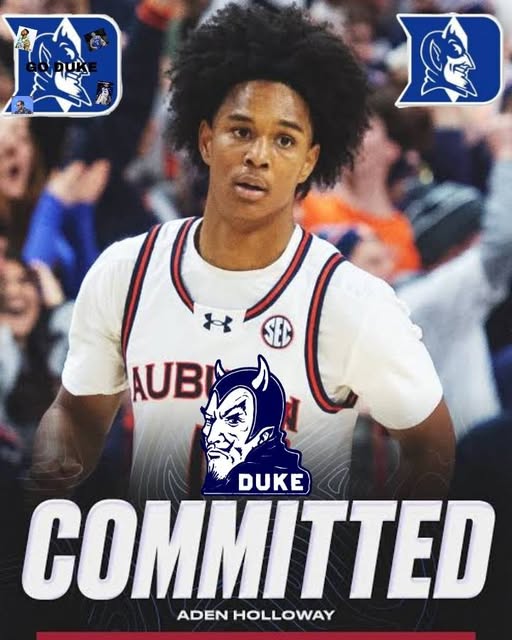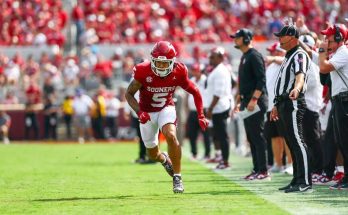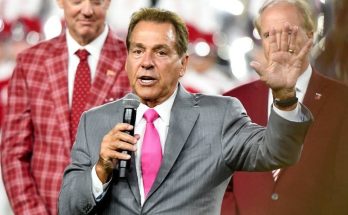The battle for the nation’s No. 1 high school basketball player has officially come to an end, and it’s Duke that has emerged victorious once again. After months of speculation, heated recruiting wars, private visits, and whispers throughout the grassroots basketball circuit, the top-ranked recruit in America has made his decision: he is headed to Durham.
With the stroke of a pen and a heartfelt announcement surrounded by family and coaches, the generational five-star talent—widely regarded as the most complete prospect in over a decade—committed to the Duke Blue Devils, choosing the storied ACC powerhouse over Florida, Auburn, and Tennessee. The announcement, which sent shockwaves through the college basketball world, solidified Duke’s position as the epicenter of elite talent development in the NIL era and reaffirmed what many already suspected: the Brotherhood still reigns supreme.
For months, programs across the country had done everything in their power to lure the prodigy. Florida rolled out the red carpet. Auburn promised immediate stardom. Tennessee emphasized family, culture, and modern development strategies. But Duke had something else. It had history. It had legacy. It had the gravity of generations of legends, NBA pipelines, Cameron Crazies, and banners that hang high above Coach K Court. Most of all, it had belief—and that was more than enough.
The commitment marks another triumph for Duke head coach Jon Scheyer, who has proven time and again that he is more than capable of continuing the dynasty built by Mike Krzyzewski. Since taking the reins, Scheyer has not only kept Duke at the forefront of the college basketball conversation but elevated it with a relentless recruiting strategy, deep player relationships, and a culture built on authenticity. Landing the No. 1 player in the country is the latest—and arguably most significant—recruiting victory of his young head coaching career.
Standing at 6-foot-9 with a freakish wingspan, elite footwork, and an uncanny ability to control the pace of a game, the newly committed phenom is being hailed as a hybrid between Kevin Durant and Jayson Tatum. Scouts rave about his defensive versatility, shot-making confidence, and innate court awareness. He can handle the ball like a guard, protect the rim like a center, and shoot like a seasoned NBA wing. In short, he’s everything a coach dreams of—and then some.
“He’s the type of player that can change the entire trajectory of a program, even one as elite as Duke,” one veteran scout said. “He brings that rare combination of physical dominance and mental sharpness that you just don’t see very often. You build championships around guys like him.”
That championship vision is precisely what attracted him to Duke. Though all four finalists made compelling pitches and had legitimate ties—Florida’s SEC infrastructure, Auburn’s recent tournament pedigree, Tennessee’s coaching culture—none could match the total package offered by the Blue Devils. At Duke, he saw more than a stopover on the way to the NBA. He saw a brotherhood. A legacy. A challenge.
“This isn’t just about one year,” he said during his televised announcement. “This is about growing as a man, as a leader, as a player. It’s about being part of something bigger than myself. I chose Duke because I believe in what they stand for. I believe in Coach Scheyer. I believe in the vision.”
His words were a dagger to the hopes of SEC fans everywhere. Florida had made a late push with a groundbreaking NIL offer and an aggressive marketing campaign promising to build his brand. Auburn head coach Bruce Pearl had formed what insiders believed to be a close bond with the recruit, hosting multiple private dinners and inviting the family into the inner workings of the Tigers’ program. Tennessee had kept the pressure on until the very end, with an emphasis on fit, development, and character.
But in the end, Duke’s consistency, reputation, and clarity of vision proved to be the difference. From the moment the Blue Devils began recruiting him, there was a sense of inevitability. The coaching staff made dozens of visits to his high school games, attended nearly every EYBL session, and fostered a relationship with his inner circle that went beyond basketball.
“Duke was real from day one,” his high school coach said. “They didn’t promise him the world. They promised him hard work, accountability, and the chance to be part of something great. That mattered.”
That relationship extended to Cooper Flagg, Duke’s current star and Wooden Award winner, who played a quiet but meaningful role in the recruitment process. Sources say Flagg spoke with the recruit several times about life at Duke, the demands of playing at the highest level, and the camaraderie of the team.
“Coop didn’t try to sell him,” one person close to the situation said. “He just told him the truth—what it’s like to compete every day, to be pushed, to wear that jersey with pride. That kind of honesty goes a long way.”
With Flagg headed to the NBA after a historic season, the opportunity for the No. 1 player to step into the spotlight at Duke became all the more enticing. There’s no question he will be handed the keys to the offense, but he also knows nothing will be handed to him without sacrifice and effort.
“Every great player that came through Duke had to earn it,” he said. “I’m not coming to be comfortable. I’m coming to work.”
The announcement sent a jolt through social media, where fans and players alike celebrated the commitment. Duke alumni like Jayson Tatum, RJ Barrett, and Zion Williamson posted congratulatory messages. NBA scouts quickly began slotting him into mock drafts as the presumptive No. 1 overall pick in 2026. Opposing fanbases began to panic—knowing full well what kind of damage a talent like this could inflict come March.
For Florida, Auburn, and Tennessee, the loss stings—not just because of the talent missed, but because of the symbolism. All three programs had taken steps in recent years to close the recruiting gap with traditional blue bloods. Each had made top-tier facilities investments, built deep NIL war chests, and hired elite support staffers. This recruitment was a test. Duke passed. The others came close but fell short.
Now, the attention shifts to what’s next. For Duke, the future couldn’t be brighter. Alongside a promising core of young players and another top-three recruiting class, the arrival of the No. 1 player in the country ensures the Blue Devils will once again be national title contenders. His ability to impact both ends of the court will give Scheyer incredible flexibility—whether he’s playing the point, anchoring the defense, or becoming the go-to scorer in crunch time.
But it’s not just the wins that matter. This commitment sends a clear message to the college basketball world: Duke isn’t going anywhere. In an era where talent is more transient than ever, where G-League and overseas options loom large, where NIL can distort long-term development, Duke continues to thrive by doubling down on culture, tradition, and purpose.
That purpose resonated with the newest member of the Brotherhood.
“Everyone wants to go where the lights are bright,” he said. “But I wanted to go where I could become the best version of myself—on the court and off. That’s Duke.”
And with that, the college basketball world took notice. The No. 1 player in America is officially off the board, and he’s headed to one of the most iconic programs in the history of the sport. Blue bloods may ebb and flow, but Duke? Duke endures. Duke evolves. Duke wins.
Now, the countdown begins. To Midnight Madness. To his first game at Cameron Indoor Stadium. To the moment the jersey goes on, the crowd erupts, and the world gets its first real glimpse of greatness in motion.
The No. 1 player in America is Duke-bound—and the basketball world will never be the same.



